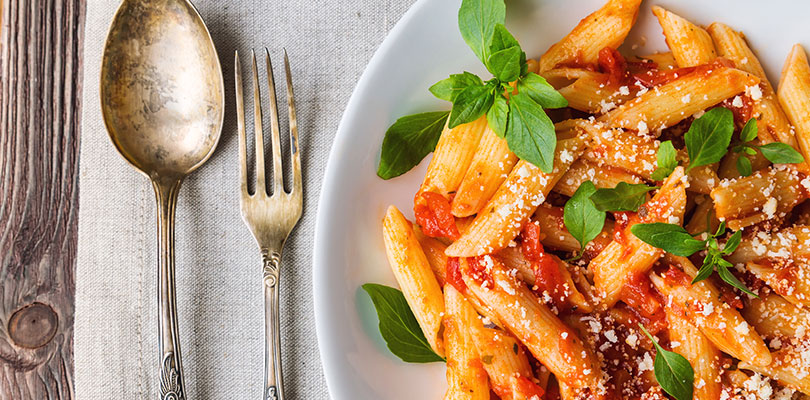
Photo Credit: gkrphoto / iStockPhoto.com
How to Add More Calories for Health, Recovery and Energy
In a society obsessed with losing weight, it can be difficult to find a healthy guide to gaining weight. After all, those who need to pack on the pounds are in the minority, and with a plethora of calories at their doorstep, it can seem like the solution is clear and easy.
In reality, underweight people often face as many health risks as overweight people, and it’s often just as difficult for them to reach a healthy weight.
Chronic disease is a primary obstacle to weight gain, while some people struggle to regain lost weight after major surgery or illness. For others, skinny is their (unwanted) norm. Regardless of the cause, staying underweight for too long can lead to health problems and injury.
While gaining weight in a healthy manner can be difficult, it’s certainly not impossible. The first steps are to separate healthy and unhealthy approaches, then find the techniques that mesh with your goals and personality.
Tune in to Healthy Calories
Many foods are high in calories. Many foods are healthy. Your challenge is to find the ones that check both boxes.
If you load up on empty calories, there’s a very good chance you’ll gain weight — but you’ll also gain a higher risk of heart disease, type 2 diabetes and other health problems.
To gain weight in a healthy fashion, you’ll have to take in about 500 more calories than you burn each day, and those calories should come with a balance of fat, carbohydrates and proteins, plus an array of nutrients.

Photo Credit: Valentina_G / iStockPhoto.com
Get in Touch With Calorie Density
Foods that contain a lot of calories in a small serving are considered calorie-dense, and these are your friends. They provide a good deal of energy without filling you up too much, which means you can eat more of them.
As long as they have a healthy helping of nutrients, they should make up a big part of your diet if you’re trying to gain weight.
Nuts, dried fruit, cheese, eggs and dense fruits like avocado are excellent places to begin. Breads and cereals (particularly granola) are also high in calories, especially if they include an abundance of whole grains and healthy additions.

Photo Credit: Anaiz777 / iStockPhoto.com
Turn Familiar Dishes Into High-Cal Versions
Attempting a big dietary change is challenging — no matter which direction you happen to be going. Overhauling your menu with a lot of new ingredients, flavors and textures can be too much for your taste buds to handle, and your digestive system might react poorly, too.
One solution is to take your favorite dishes and turn up their calories with a few easy adjustments.
First, get rid of low-fat dairy options: sub half and half for milk in your coffee and start topping more meals with butter and cheese. These are natural, high-fat options your body can process well, with enough nutrients to keep your muscles, bones and organs strong. Sauces are also quick ways to boost the calorie count of any meal.

Photo Credit: itman__47 / iStockPhoto.com
Don't Skimp on (Healthy) Carbs
Carbs have developed a bad reputation among the lean crowd, which means they’re perfect for anyone looking to gain — right? Well, carbs are generally calorie-packed, and they do offer a lot of energy, but it’s still important to choose wisely to avoid other potentially hazardous health effects.
Vegetables, fruits and whole grains deserve to play a major role in your daily diet. They’re packed with vitamins and antioxidants, they give you loads of energy, and they can be surprisingly calorie-dense (especially grains like flax, brown rice and wheat germ).
Carbs will also help your body use the protein you consume to put on muscle, rather than burn that protein for fuel.

Photo Credit: alexskopje / iStockPhoto.com
Stick to Your Set Meal Schedule
Many nutritionists suggest eating at least six times a day to gain weight, scheduling three major meals interspersed with snacks. It can take some time to get into the habit of eating all day long, but your body will soon adapt.
Try not to miss any one of your meals, and make sure each contains at least 500 calories. Snacks should weigh in at 100 to 200 calories each.
If you’re not sure where to squeeze more food into your day, try adding in a morning snack a couple of hours after breakfast, and a nighttime snack sometime after dinner. You’re probably a bit more relaxed at these points, and can spare some time and energy for an extra bite to eat.
Even though some level of irritability is a normal, healthy part of life, it is also something that can have damaging repercussions.

Photo Credit: JANIFEST / iStockPhoto.com
Supplement With Meal Replacements
Both store-bought meal replacements (like Boost or Ensure) and the homemade variety are generally good choices for people on the go, especially if they need a quick burst of energy. These drinks can help you, too, but instead of using them as meals in themselves, use them as meal additions.
For instance, a protein-packed yogurt, oat and fruit smoothie could serve as a balanced breakfast, and it sure is filling, but how you frame that breakfast shake can make quite a difference in how you perceive it.
Pour it into a smaller juice glass (you’ll want to save room for the solid fare, after all), and concentrate on the fact that it’s a drink rather than a food. This way, you might be more likely to pair it with your meal rather than enjoy it in place of a meal.

Photo Credit: artisteer / iStockPhoto.com
Switch up Your Smoothies
Smoothies are great vehicles for calories, but one problem with consuming a relatively uniform, predictably-textured dish is it can get boring fast. Shake things up with different smoothie recipes, and don’t forget to throw in a variety of flavors and textures.
Olive oil, yogurt, flax seed, protein powder, avocado and nut butters are your calorie-dense mainstays. Make sure every concoction has at least one or two of these, but switch up the fruit, veggies and juices that round out the smoothie.
It may be worth investing in a smoothie cookbook, or browsing around for inspired blogs that offer oodles of ideas.

Photo Credit: -lvinst- / iStockPhoto.com
Make Friends With Oil
Healthy fats are fantastic mechanisms for weight gain. Just a tablespoon of olive oil has 120 calories, and it’s not difficult to get through twice that amount in one go.
Add to this the staggering amount of health-boosting antioxidants known as polyphenols, which also have great anti-inflammatory properties, and olive oil may win the prize for most useful fat.
To begin, ditch the store-bought salad dressings and make your own with an olive oil base. Start swirling olive oil into all your smooth preparations, too: oatmeal, soup, smoothies — even yogurt and pudding are prime locales for a dash of oil.

Photo Credit: Wavebreakmedia / iStockPhoto.com
Add Sleep, Subtract Stress
Rest and relaxation will help your body transfer the calories you consume to your tissues and fat stores. Every hour you’re awake instead of asleep, you’re burning more calories. Aim to get at least eight hours each night — maybe even more if you’re recovering from an injury or illness.
Stress is another enemy to health, and though the stress hormone cortisol can cause you to store more weight, the stress response could also negatively interfere with your appetite and digestion. Stress in the form of muscle-building exercise is good; emotional stress that interrupts your natural routine is bad.
Healthy weight gain is about adding muscle and a healthy amount of subcutaneous fat, not belly rolls. A balanced diet should be your top priority, and don’t skimp on the protein.
You should consider pairing your high-calorie diet with an exercise plan that focuses on strengthening you whole body, keeping your spirits high, and bolstering your self-confidence.
ITP is an autoimmune disease that causes excessive bruising and bleeding. Here are the main treatment options to look into.







